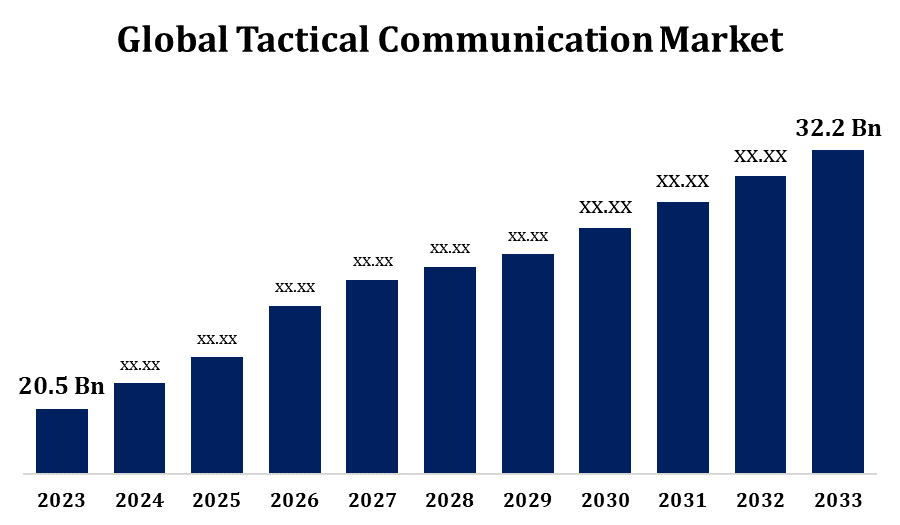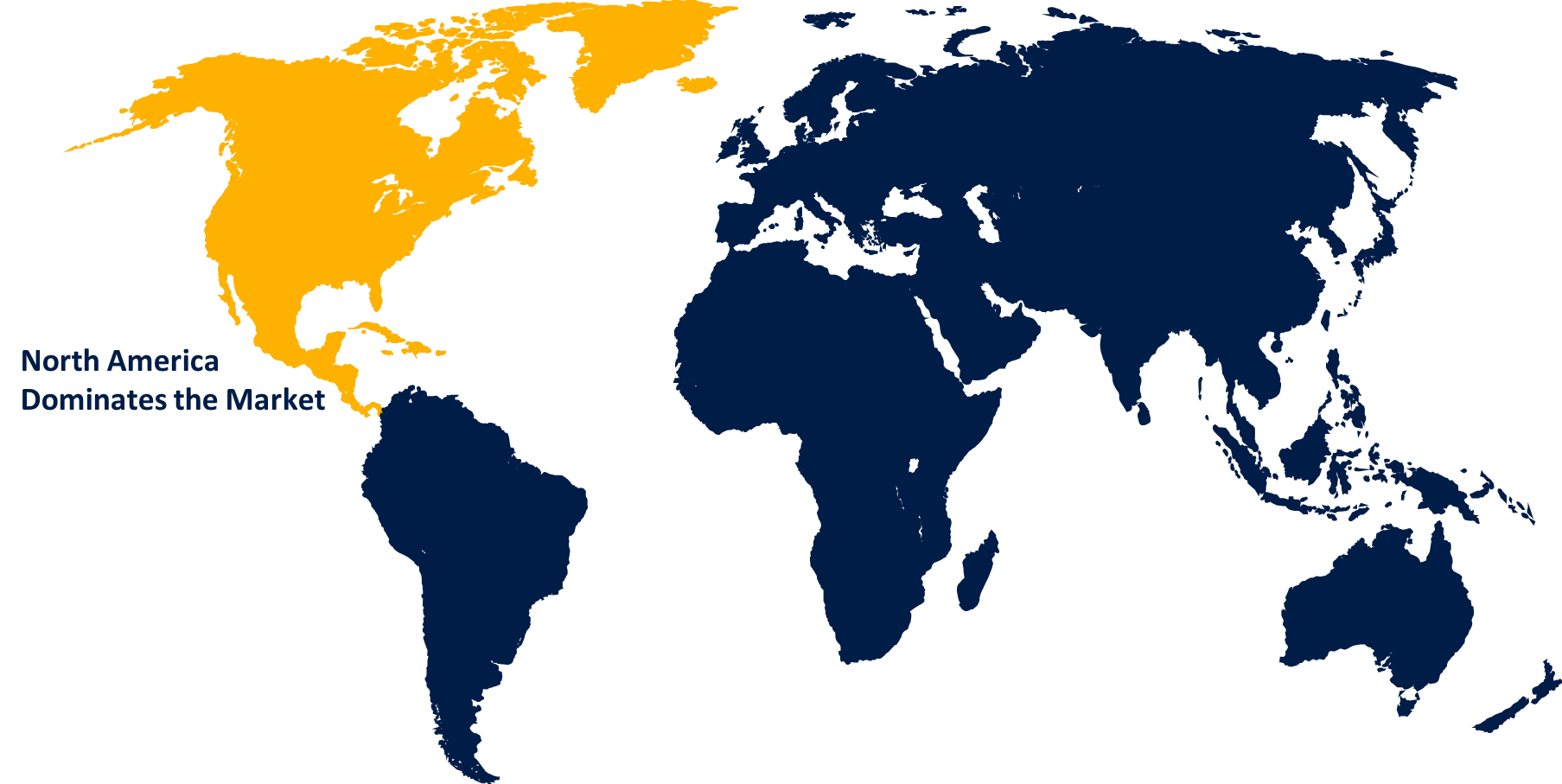Global Tactical Communication Market Size, Share, and COVID-19 Impact Analysis, By Platform (Ground, Airborne, Naval, Unmanned Systems); By Application (Command & Control, Intelligence, Surveillance & Reconnaissance, Communication, Combat); By Type [Soldier Radios, Manpacks, Vehicular Intercommunication Radio (VIC), High-Capacity Data Radio (HCDR)], and By Region (North America, Europe, Asia-Pacific, Latin America, Middle East, and Africa), Analysis and Forecast 2023 - 2033
Industry: Aerospace & DefenseGlobal Tactical Communication Market Insights Forecasts to 2033
- The Global Tactical Communication Market Size was valued at USD 20.5 Billion in 2023.
- The Market is Growing at a CAGR of 4.62% from 2023 to 2033
- The Worldwide Tactical Communication Market Size is expected to reach USD 32.2 Billion by 2033
- Asia Pacific is Expected to Grow the fastest during the forecast period

Get more details on this report -
The Global Tactical Communication Market is expected to reach USD 32.2 Billion by 2033, at a CAGR of 4.62% during the forecast period 2023 to 2033.
The tactical communication market is experiencing significant growth, driven by increasing defense budgets and the need for secure, efficient communication systems in military operations. Advanced technologies, such as software-defined radios and satellite communication, are enhancing the capability and reliability of tactical communication systems. The market is also seeing a rise in demand due to geopolitical tensions and modernization programs undertaken by various armed forces globally. Key players are focusing on developing innovative solutions to meet the evolving needs of the defense sector. Furthermore, the integration of artificial intelligence and cybersecurity measures is becoming crucial to ensure the integrity and effectiveness of communication networks. As a result, the tactical communication market is poised for robust expansion, with North America and Europe leading the way in terms of adoption and technological advancements.
Tactical Communication Market Value Chain Analysis
The tactical communication market value chain encompasses several critical stages, starting with research and development, where cutting-edge technologies and innovative solutions are conceptualized. This is followed by the design and manufacturing phase, where components such as software-defined radios, satellite communication devices, and encryption systems are produced. System integration plays a vital role, ensuring that various components work seamlessly together to form robust communication networks. The deployment stage involves installing and testing these systems in field conditions. After deployment, ongoing maintenance and support services are essential to sustain operational efficiency and address any technical issues. Key stakeholders include technology providers, system integrators, defense contractors, and end-users such as military and law enforcement agencies, all collaborating to enhance tactical communication capabilities.
Tactical Communication Market Opportunity Analysis
The tactical communication market presents substantial opportunities, driven by the increasing adoption of advanced communication technologies and the rising defense expenditures globally. Emerging markets, particularly in Asia-Pacific and the Middle East, are investing heavily in modernizing their defense infrastructure, creating a significant demand for sophisticated tactical communication systems. Innovations such as artificial intelligence, cybersecurity enhancements, and the Internet of Things (IoT) are opening new avenues for growth, enabling more secure and efficient communication solutions. Additionally, the growing emphasis on interoperability among allied forces highlights the need for standardized communication platforms. Companies that can offer versatile, scalable, and secure communication solutions are well-positioned to capitalize on these opportunities, leveraging technological advancements to meet the evolving needs of military and law enforcement agencies.
Global Tactical Communication Market Report Coverage
| Report Coverage | Details |
|---|---|
| Base Year: | 2023 |
| Market Size in 2023: | USD 20.5 Billion |
| Forecast Period: | 2023-2033 |
| Forecast Period CAGR 2023-2033 : | 4.62% |
| 2033 Value Projection: | USD 32.2 Billion |
| Historical Data for: | 2019-2022 |
| No. of Pages: | 197 |
| Tables, Charts & Figures: | 111 |
| Segments covered: | By Platform, By Application, By Type, By Region and COVID-19 Impact Analysis. |
| Companies covered:: | ASELSAN A.S., BAE Systems Plc, Cobham Ltd, Curtiss Wright, Datron World Communications, Honeywell International Inc, Hanwha Group; Huneed Technologies, Iridium Communications Inc, Elbit Systems Ltd, General Dynamics Corporation, Leonardo S.p.A, L3harris Technologies, Lockheed Martin Corporation, Northrop Grumman Corporation, Raytheon Technologies Corporation, Rohde & Schwarz, Thales Group, Viasat Inc., and other key vendors. |
| Growth Drivers: | Modernization of defense forces to drive the market growth |
| Pitfalls & Challenges: | COVID-19 Empact, Challenge, Future, Growth, & Analysis |
Get more details on this report -
Market Dynamics
Tactical Communication Market Dynamics
Modernization of defense forces to drive the market growth
As nations invest in upgrading their military capabilities, there is a heightened demand for advanced communication systems that offer secure, reliable, and real-time information exchange. Modernization programs often include the adoption of cutting-edge technologies such as software-defined radios, satellite communications, and encrypted networks, all of which enhance tactical communication capabilities. Additionally, the integration of artificial intelligence and machine learning in communication systems provides improved situational awareness and decision-making support. These advancements ensure that military operations are more coordinated and effective, leading to increased procurement of sophisticated tactical communication solutions. Consequently, the market is experiencing robust expansion, particularly in regions prioritizing defense modernization.
Restraints & Challenges
The tactical communication market faces several challenges despite its growth prospects. High costs associated with developing and deploying advanced communication systems can strain defense budgets, particularly in emerging economies. Additionally, ensuring interoperability among diverse and often legacy systems remains a significant hurdle, complicating efforts to achieve seamless communication across different forces and platforms. Cybersecurity threats pose another major challenge, as securing communication networks against sophisticated cyberattacks is increasingly complex and critical. Furthermore, rapid technological advancements necessitate continuous upgrades and training, which can be resource-intensive. Regulatory and compliance issues, varying across regions, also impact market dynamics, creating barriers for global standardization. Addressing these challenges is crucial for sustained growth and the effective modernization of defense communication infrastructures.
Regional Forecasts
North America Market Statistics

Get more details on this report -
North America is anticipated to dominate the Tactical Communication Market from 2023 to 2033. The region benefits from the presence of major defense contractors and technology innovators, which are at the forefront of developing advanced communication systems. Investments in next-generation technologies such as software-defined radios, satellite communications, and secure networks are prominent. The emphasis on interoperability and network-centric warfare further propels the demand for sophisticated tactical communication solutions. Additionally, ongoing geopolitical tensions and commitments to NATO reinforce the need for cutting-edge communication capabilities. North America's focus on integrating artificial intelligence and cybersecurity into defense communication systems positions it as a leader in the global tactical communication market.
Asia Pacific Market Statistics
Asia Pacific is witnessing the fastest market growth between 2023 to 2033. These nations are investing heavily in advanced communication technologies to enhance their military capabilities and ensure secure, efficient information exchange during operations. The rising geopolitical tensions and the need for improved situational awareness and interoperability are further fueling demand. The region is witnessing a surge in the adoption of software-defined radios, satellite communications, and encrypted systems. Local defense manufacturers and technology providers are collaborating with global players to bring innovative solutions to market. As a result, the Asia Pacific tactical communication market is set to expand rapidly, contributing to the overall growth of the global market.
Segmentation Analysis
Insights by Platform
The ground segment accounted for the largest market share over the forecast period 2023 to 2033. This segment encompasses a range of equipment, including mobile and fixed communication units, command and control systems, and portable radios. The increasing complexity of modern warfare and the emphasis on network-centric operations necessitate advanced ground communication solutions. Additionally, technological advancements such as software-defined radios, enhanced encryption techniques, and the integration of artificial intelligence are improving the performance and security of ground-based systems. The modernization programs and increasing defense budgets across various nations further propel this growth.
Insights by Application
The command and control segment accounted for the largest market share over the forecast period 2023 to 2033. As military operations become increasingly complex and dynamic, the demand for robust command and control solutions is rising. Technological advancements such as artificial intelligence, big data analytics, and enhanced cybersecurity measures are driving the development of sophisticated systems capable of processing and disseminating vast amounts of information swiftly and securely. Additionally, modernization efforts and increased defense spending across various nations are bolstering this segment's growth. Consequently, the command and control segment is crucial in enhancing operational efficiency and effectiveness, significantly contributing to the overall expansion of the tactical communication market.
Insights by Type
The soldier radios segment accounted for the largest market share over the forecast period 2023 to 2033. These radios are essential for providing reliable communication capabilities to individual soldiers on the battlefield, enabling them to maintain contact with command centers and fellow troops in real-time. Key developments include lightweight, ruggedized radios with enhanced encryption features to ensure secure communications in diverse operational environments. The integration of technologies such as GPS, voice recognition, and health monitoring further enhances the functionality and effectiveness of soldier radios. As defense forces prioritize enhancing soldier capabilities and interoperability, the demand for advanced soldier radios continues to rise, positioning this segment as a critical driver of growth within the tactical communication market.
Recent Market Developments
- In February 2022, L3Harris Technologies Inc developed next-generation secure manpack radios with integrated communications security for the United States Special Operations Command, allowing commando squads to communicate on frequencies ranging from 30 to 2,600 MHz with embedded communications security.
Competitive Landscape
Major players in the market
- ASELSAN A.S.
- BAE Systems Plc
- Cobham Ltd
- Curtiss Wright
- Datron World Communications
- Honeywell International Inc
- Hanwha Group; Huneed Technologies
- Iridium Communications Inc
- Elbit Systems Ltd
- General Dynamics Corporation
- Leonardo S.p.A
- L3harris Technologies
- Lockheed Martin Corporation
- Northrop Grumman Corporation
- Raytheon Technologies Corporation
- Rohde & Schwarz
- Thales Group
- Viasat Inc.
Market Segmentation
This study forecasts revenue at global, regional, and country levels from 2023 to 2033.
Tactical Communication Market, Platform Analysis
- Ground
- Airborne
- Naval
- Unmanned Systems
Tactical Communication Market, Application Analysis
- Command & Control
- Intelligence
- Surveillance & Reconnaissance
- Communication
- Combat
Tactical Communication Market, Type Analysis
- Soldier Radios
- Manpacks
- Vehicular Intercommunication Radio (VIC)
- High-Capacity Data Radio (HCDR)
Tactical Communication Market, Regional Analysis
- North America
- US
- Canada
- Mexico
- Europe
- Germany
- Uk
- France
- Italy
- Spain
- Russia
- Rest of Europe
- Asia Pacific
- China
- Japan
- India
- South Korea
- Australia
- Rest of Asia Pacific
- South America
- Brazil
- Argentina
- Rest of South America
- Middle East & Africa
- UAE
- Saudi Arabia
- Qatar
- South Africa
- Rest of the Middle East & Africa
Frequently Asked Questions (FAQ)
-
1. What is the market size of the Tactical Communication?The global Tactical Communication Market is expected to grow from USD 20.5 billion in 2023 to USD 32.2 billion by 2033, at a CAGR of 4.62% during the forecast period 2023-2033.
-
2. Who are the key market players of the Tactical Communication Market?Some of the key market players of the market are ASELSAN A.S.; BAE Systems Plc; Cobham Ltd; Curtiss Wright; Datron World Communications; Honeywell International Inc; Hanwha Group; Huneed Technologies; Iridium Communications Inc; Elbit Systems Ltd; General Dynamics Corporation; Leonardo S.p.A; L3harris Technologies; Lockheed Martin Corporation; Northrop Grumman Corporation; Raytheon Technologies Corporation; Rohde & Schwarz; Thales Group; Viasat Inc.
-
3. Which segment holds the largest market share?The ground segment holds the largest market share and is going to continue its dominance.
-
4. Which region dominates the Tactical Communication market?North America dominates the Tactical Communication market and has the highest market share.
Need help to buy this report?